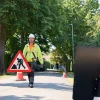SMF Study Identifies Weaknesses in UK 5G Mobile Deployments

A new report from the Social Market Foundation (SMF), which is a cross-party think-tank, has highlighted how the UK is still a long way from reaping the benefits of achieving ubiquitous 5G mobile (mobile broadband) connectivity. The report finds this is partly because previous policies toward mobile telecoms have “unintentionally hindered investment.” Solving that won’t be easy.
According to Ofcom’s data from January 2024 (here), some 85-92% of UK premises can now get outdoor 5G coverage by at least one operator, although this collapses to just 16-28% when looking at outdoor coverage by all operators combined. The regulator doesn’t yet offer a 5G figure for geographic coverage, but if they did, it would surely be a fair bit lower than the 85-92% mentioned earlier.
The new SMF report – ‘Growing Connections‘ (PDF) – similarly examines older (2023) crowdsourced data from Opensignal to show that 5G availability, when measured by the proportion of time users spent with an active 5G connection, sees the UK trailing many countries. For example, 5G users in the UK only have access to it around 10% of the time, which compares poorly with India (43%), South Korea (38%), France (20.6%) and Italy (17.9%) etc.
Advertisement
The report also highlights an analysis of international 5G download speeds, which was again sourced from Opensignal and suggests that the UK, which scored 113Mbps, is amongst the slowest. On the one hand, 113Mbps might not sound too bad, but many of the other big countries deliver between 133Mbps (Italy) and up to 437Mbps (South Korea).
Overall, the UK does seem to be lagging behind in its 5G performance and coverage, which is disappointing given that we were one of the first countries to start rolling the technology out. The SMF then highlights how another study had shown that, by 2035, “widespread availability and use of 5G could add £159 billion to the UK economy“. But such predictions should always be taken with a pinch of salt, since good 4G mobile services can already deliver many of the benefits that 5G is often associated with.
What went wrong
The report goes on to highlight how “a number of factors including previous policies towards the mobile telecoms sector have unintentionally hindered investment“. But surprisingly, there’s no specific mention of the previous UK Government’s decision to ban Huawei after the rollout had begun, which came as quite a significant blow to most mobile operators and set deployment plans back.
Instead, the report talks more generally about the Government and Ofcom’s “approach to spectrum,” which focuses on both the high costs involved in accessing / using mobile spectrum and the shortness of spectrum licences that are awarded (i.e. deterring “very long-term investment” and making it “less useful as an asset“). But we’d add that Ofcom being slow to release more spectrum bands for 5G hasn’t helped much either (e.g. other countries have had access to mmWave bands for years, but UK mobile operators are still waiting).
Advertisement
Curiously, the report does more specifically remark upon the impact from “some of the efforts to try cutting the cost of building infrastructure“(i.e. making it cheaper for MNOs to operate mobile masts), which it says “have resulted in less land being supplied for infrastructure and an unprecedented rise in the number of disputes between landowners and infrastructure builders along with a significant increase in costly litigation“.
At this point it’s worth highlighting that the new report was “kindly supported by APWireless,” which is a company with its own vested interests. Some operators view them as being a land aggregator, which adopts a lease premium model that sometimes seems to involve buying out expiring leases from landowners and charging mobile operators a lot more for them in the process.
Naturally, a company like APW may thus have issues with the new government’s potential plans for reforming the Electronic Communications Code (here), which governs land / property access – particularly if those changes end up threatening their business model.
The report then goes on to highlight other obstacles, such as the well-documented delays in the planning system and related objections to new masts, which are complex areas to resolve as politicians don’t want to upset the electorate. But at the same time, they also have to balance that against the need to support the roll-out of better mobile and broadband networks, particularly in some of the hardest to reach areas, where commercial models often struggle.
Advertisement
Finally, the report notes how there have been calls for consolidation (i.e. allowing the Vodafone and Three UK merger) to address the “comparatively low levels of profitability” of the country’s four mobile network operators, which is seen as limiting the investment that is needed. But the evidence around the impacts of consolidation remains mixed, with the competition watchdog (CMA) noting that it may reduce competition and result in higher prices for consumers (negotiations are taking place to try and address that).
Sadly, the report doesn’t seem to include a list of clear recommendations and is more attempting to summarise – at a high level – the current state of play and where it perceives the problems to exist, albeit at least in part coming from the perspective of a company that harbours a particular vested interest in this area. Take with a pinch of salt.
Mark is a professional technology writer, IT consultant and computer engineer from Dorset (England), he also founded ISPreview in 1999 and enjoys analysing the latest telecoms and broadband developments. Find me on X (Twitter), Mastodon, Facebook, BlueSky, Threads.net and Linkedin.
« Wi-Fi Calling and VoLTE Now Available to All Giffgaff UK Customers























































The 5G signal started off very strong and good, then we started ripping out the Huwawei equipment and it got worse and worse
Unfortunately they had the best antennas but usa has got to ban anything made in China i Guess that runs critical infrastructure even if the source code has been reviewed
Huwawei was full 5G but the uk follow america and belive Donald duck with china spying and look at us now compare to america there 5G is top notch and we here scraping for scraps
Do we NEED 5G? I was once behind a guy wandering along watching football on his phone. Years ago he’d have had a little radio in his pocket and an earpiece. Did he NEED to watch football on his phone or does he WANT to watch football on his phone? He’s doing it because he can, because he’s been sold it.
I like your thinking, but this has been going for years people getting better technology to do things.
when I was a lot younger, I used to have a cassette player/recorder, that I used to use to listen to music outside and also a small radio, then at some point I had a radio cassette. Sony produced the Walkman, a portable cassette player that you can put in your pocket. The CD came out and we ended up with portable CD players, still have two of them here. Don’t forget the mini disc player, which you could also put your own music on. Mp3 players with hard drives built in and eventually built in memory or some sort of removable memory.
Now we can use our phones.
We were sold them things, did we really need to update them? I never had a pocket sized cassette player, the first thing I had that I could really carry around with me was my Portable CD player, then i went for a Minidisc player.
We are sold a lot of things we don’t really need, I was sold FTTP, I was happy with FTTC, come to think of i was not really sold FTTP, but more or less forced.
As for 5G, I don’t think it is really needed from mobile phones, but maybe for people who can’t get decent broadband at home.
5G is useless around here, when I get a new phone at some point 5G will be disabled on it as I know people who have it, and they end up losing calls as it changes from 5G to 4G.
Don’t get me wrong I was looking forward to SA 5G but I do not understand the strategy used by operators.
In my town, a planning application was submitted 10meters away from a child’s bedroom, this was not in line with ICNIRP guidelines.
Lots of locals and councillors protested against the mast, rather than withdraw the application the applicant awaited the inevitable refusal. Now the whole town has their pitchforks out for 5G.
Am I missing something or was this pure stupidity by the phone company?
Banning Huawei on the orders of Donald Trump put the UK’s 5G coverage back by 5 years.
I am seeing nothing impressive, still havent found any of these mystical areas that have speeds in the multiple 100s, my local cell reports 5G to my phone and I am lucky to get over 20mbit in the evening and no more than 100-150 off peak, 150 seems to be its upper limit which is the same as 4G performed.
We have the fake 5G problem of course as well, where one can see a 5G icon on the phone but it doesnt mean the phone is using a 5G signal. Which after some assistance diagnosing seems to be the case in my situation.
Countries including Germany, Italy, France, Denmark, Japan and others didn’t ban Huawei because Donald Trump told them, that is nonsense. They banned them because Huawei is a national security risk. Time and time again, equipment coming from the Republic of China has been found to have back-doors that would allow the CCP to take control of the system. That is fine for your home router but critical coms infrastructure is a different matter. Yes I am pretty sure that our own governments have their own back-doors too.
I’m sorry if this is a hot take, but providers should be forced to deploy their spectrum before they even get mmWave. I’m just within a mmWave area and do you want to know what my local mast has on O2?
Band 1 and 20. They shouldn’t even consider deploying mmWave before they deploy more bands honestly (Vodafone is B1+7+20+n78), because frankly it is disgraceful. O2 could theoretically deploy poles with B1+3+8+20+28+40+n78 (granted I doubt they’ll unwind any soon) if they actually cared about capacity (which they don’t).
Most of the public and planning authorities don’t want poles or masts. Cant really blame them, I wouldn’t want one in my road.
The benefits do not outweigh the visual damage, so not much the phone companies can do.